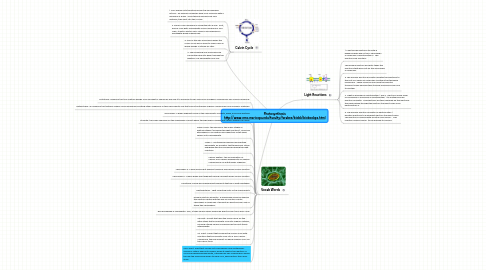Photosynthesis http://www.emc.maricopa.edu/faculty/farabee/biobk/biobookps.html
by Mike Gumino

1. Light Reactions
1.1. 1. Light forces electrons to enter a higher energy level in the 2 chlorophyll a molecules of photosystem 2. The electrons are "excited."
1.2. The primary electron acceptor takes the electrons that were lost by the chlorophyll a molecules.
1.3. 3. The primary electron acceptor donates the electrons to the first of a series of molecules located in the thylakoid membrane. These molecule are called the elecrton transport chain because they transfer molecules from one to another.
1.4. 4. Light is absorbed in Photosystem 1 and 2. Electrons move a piar of chlorophyll a molecules in photosystem 1 to another primary electron acceptor. The electrons are then replaced by the electrons the have passed through the electron transport chain from photosystem 2.
1.5. 5. The primary electron acceptor of photosystem 1 donates electrons to a different electron transport chain. The electrons combine with a proton and NADP+. This reaction causes NADP+ to be reduced to NADPH.
2. Calvin Cycle
2.1. 1. CO2 diffues into the stroma from the surrounding cytosol. An enzyme combines each CO2 molecule with a molecule or RuBP. Since these molecules are very unstable, they split into two 3-PGA.
2.2. 2. Each 3-PGA molecule is converted into a G3P. First, each 3-PGA gets a phosphate froma molecule of ATP. Then, it gets a proton form NADPH and realeases a phosphate group making G3P.
2.3. 3. One of the G3P molecules leaves the Calvin Cycle and is used to make carbs in which energy is stored for later.
2.4. 4. The remaining G3P molecules are converted back into RuBP through the addition of a phosphate from ATP.
3. Vocab Words
3.1. autotroph- organism that can capture energy from sunlight or chemicals and use it to produce its own food from inorganic compounds; also called a producer
3.2. heterotroph- an organism that obtains organic food molecules by eating other organisms or their byproducts and that cannot synthesize organic compounds from inorganic materials
3.3. chlorophyll- a green pigment found in the chloroplasts of plants, algae, and some bacteria
3.4. stomata- the small openings on the undersides of most leaves through which oxygen and carbon dioxide can move
3.5. Calvin Cycle- the second of two major stages in photosynthesis (following the light reactions), involving atmospheric CO2 fixation and reduction of the fixed carbon into carbohydrate
3.6. NADP+- nicotinamide adenine dinucleotide phosphate, an acceptor that temporarily stores energized electrons produced during the light reactions
3.7. carbon fixation- the incorporation of carbon from carbon dioxide into an organic compound by an autotrophic organism
3.8. chlorophyll a- a blue-black plant pigment having a blue-green alcohol solution
3.9. chlorophyll b- a dark-green plant pigment having a brilliant green alcohol solution
3.10. Carotnoid- yellow and orange plant pigments that aid in photosynthesis
3.11. photosystems - light collecting units of the cholorplasts
3.12. primary electron acceptor- a specialized molecule sharing the reaction center with the pair of reaction-center chlorophyll a molecules; it accepts an electron from one of these two chlorophylls
3.13. glyceraldehyde-3-phosphate- G3P, a three carbon sugar produced directly from the Calvin cycle
3.14. C3 Plant- a plant that uses the Calvin cycle for the initial steps that incorporate CO2 into organic material, forming a three-carbon compound as the first stable intermediate
3.15. C4 Plant- a plant that prefaces the Calvin cycle with reactions that incorporate CO2 into a four-carbon compound, the end product of which supplies CO2 for the Calvin cycle
3.16. CAM Plant- plant that carries out crassulacean acid metabolism; carbon is initially fixed into organic acids at night in the reaction of CO2 and phosphoenolpyruvate, catalyzed by PEP carboxylase; during the day the acids break down to yield CO2, which enters the Calvin cycle


